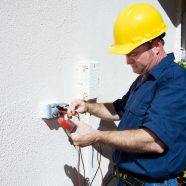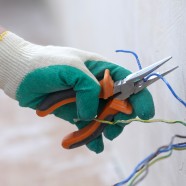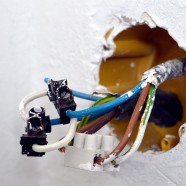Cost Implications of a Residential Rewiring Project in South Florida
Older homes, like many in the south Florida area, often need a complete residential rewiring to keep them safe and up to code. If your home is more than 50 years old, it’s time to consider contacting a professional electrical contractor to inspect the condition of your home’s wiring. Even if age isn’t a consideration yet, there are other signs that indicate you need to have your wiring inspected. Look for:
- A faint burning smell or sizzling sound, especially when appliances are turned on
- Circuit breakers that trip or fuses that blow on a frequent basis
- Brown discoloration on switches and outlets and the walls around them
Residential rewiring isn’t a minor job, and the cost depends on many variables. It’s a serious renovation job, but in many instances there are ways to minimize the costs.
The Home Rewiring Process
Rewiring your home involves removing all the old wiring and replacing it with newer, non-metallic wire. This new wire doesn’t get hot when surrounded with insulation, it’s easier to work with and it’s safer inside your walls.
In the most elaborate wiring jobs, electrical contractors remove the interior walls, replace all the wiring and rebuild the walls with the new wiring inside. This can take a lot of time and can be the most expensive method, as well as doing damage to older, historically significant buildings.
Contractors can replace the wiring using a series of small holes cut into the walls, along with a thin line called fish tape that draws the wire from one small hole to another. This method requires patching holes, but it keeps the integrity of older plaster walls while installing newer, safer wiring. Running wires behind existing walls can be much less expensive than replacing the walls themselves, and can save homeowners thousands of dollars in construction costs.
Residential Rewiring Costs
The price of each part of the job will vary from season to season, but it’s important to remember that many details go into the final cost. It’s not the price of the job itself as much as it is that of each individual part of the job.
Building permits are often the first item you’ll spend money on when having wiring redone. The permits will cost the same whether you or your electrical contractor pulls the permits, but your professional knows which ones you need and won’t waste money on those you don’t.
If you’ve got an older house that still has a fuse box, it will need to have a new circuit breaker installed. This can cost up to $3000, depending on the size of your home’s electrical demand load.
While you can save a bit of money reusing your old switches and outlets, you’ll still have to pay for your contractor to install them. A residential electrical south Florida contractor will charge around $100 per outlet for installation.
The most expensive materials cost is, of course, for the wiring itself. New wire can cost thousands of dollars, even for the smallest home, but it can pay off in peace of mind.
The most important item on your home rewiring job is the cost of a professional electrical contractor. Rewiring your home is never a DIY job; it takes a knowledgeable professional to safely install an electrical system that will last for decades.
Read MoreElectrical Faults: Are There Clues in Your Utility Bills?
If you’ve ever received a utility bill that is much higher than normal, then you’ve probably had the same reaction everyone does. Chest pains, followed by an angry call to the electric company to tell them they’ve made a mistake. Often, it is an administrative error that sends your residential or commercial electrical bills skyrocketing, but sometimes, the cause is inside your home, and not with city administrators. Here’s what you know about how high electrical bills can be a clue that there’s something wrong with your wiring or that you need electrical protection.
Faulty Meter
The first, and most obvious electrical problem that may be causing spikes in your utility bills is that there is a faulty meter. If there is a problem with your electric meter, it may continue running even when everything in your home is switched off.
Most people don’t give their meter a second thought until they get a very high bill, but there are ways to check if it’s working properly. If you switch off every breaker in your home, and the meter is still turning, then that’s a clear sign that all is not well! If you do suspect that your meter is faulty, contact the electric company as soon as possible, as it will need to be repaired or replaced.
Faulty Water Heater
Another major cause of high power bills is a water heater that is not working properly. Sediment in a hot water heater tank, or build up on the element can mean that the unit has to work a lot harder to heat the water for your home, and those costs can add up quickly.
If it’s been awhile since you’ve replaced your hot water heater, or you’ve never had it replaced or checked, then this is definitely something you will want to investigate.
Faulty HVAC
Your air conditioner is another piece of equipment you will want to have checked if you have a much higher than normal power bill. Even a small refrigerant leak can cause your air conditioner to work much harder than usual, and that can cause a huge spike in your power bill. Worse still, since there won’t be a noticeable change in the noise or operation of the A/C unit, most people will have no idea until they get their power bill!
Shorts and Other Electrical Issues
Sometimes, spikes in power usage are due to short circuits, or power leaks. Sometimes, people find that there’s a concealed extension cord running from their garage to an alley or a neighbor, and someone is actually stealing power. In the case of the latter, you should call the cops, but in the case of the former, you definitely want an electrical contractor to take a look.
Short circuits or faulty wiring can be dangerous as well as costly, and if the power is leaking onto a conductor, they could have lethal consequences. If there is any concern, it’s always best to hire a professional to trace the problem, and offer solutions for electrical protection, and to ensure that your home is safe for everyone who lives there.
Never Ignore the Signs
A very high power bill is almost always a sign that something is amiss, unless you’ve had guests staying or started working on a major project in your garage, and you know why you’ve had a usage spike. If you’re not sure, call an electrician in South Florida, and get to the bottom of the problem. It’s the best solution all round.
Read MoreHow to Run New Wires Through Your Home’s Old Walls
If you’re buying an older house, or your family has grown since you bought your existing home, remodeling and renovation are probably on your mind. Bathroom and kitchen remodeling are the most popular renovation jobs in the country, but you’ll have to think about residential wiring no matter what room you want to work on. Electrical remodeling can be as simple as adding an outlet or as complex as creating an entirely new circuit for part of a room. While elaborate jobs should always be left up to professional electricians, you can do some simple tasks if you’re confident with basic tools.
Preparing for the Job
Doing your own electrical remodeling is only possible if you’re fanatical about the safety rules. If you never cut any corners you’ll be able to do some simple jobs, but if you’re the type to take shortcuts, then rather leave the job to the professionals.
If you do want to proceed with the project, begin by turning off the power to the room at the breaker box. If it’s too dim in the room, use bright flashlights to see your work. Use a voltage tester to make sure the outlet you’ll be working on doesn’t have any power going to it. Once you’re sure there is no power running to the outlet, remove any objects hanging on the walls in that area, such as televisions or paintings. Use a stud finder to locate the studs in the wall, and mark them with a pencil.
Making the Cuts
The phrase “measure twice and cut once” may never be more important as it is in reference to making holes in your wall. Be very strategic in the placement of the holes so that you don’t make larger ones than necessary.
Measure and draw outlines with a pencil for all the drywall holes you need to make. Cut a hole across all studs for easier access to the area you’ll be working in. Use a drywall saw to make clean cuts, and set each square aside after you remove it. You’ll be replacing these squares when the electrical work is finished. If you’ll be traveling the wire for the length of the wall, cut an interim hole to help you to guide it to its final destination.
Use a right-angle saw with a round bit to cut holes through the studs for the wires to go through. You can rent these specialty saws through some hardware stores and most home improvement centers. If you’ll be running multiple cables through the wall, such as for a wall-mounted television, drill a separate, larger hole for holding conduit.
Running the Wires
Begin at the highest point and run the wires down through the inside of the wall. Gravity will help the wire to go where you want it to, but if you have any problems sending the wire to the right place, use fish tape to guide it. Fish tape, otherwise known as an electrician’s snake, is a long coil of wire designed to help pull wires through long expenses of wire. It’s coiled up but stiff, much like a metal measuring tape.
Feed the end of the tape through one hole in the wall and feed it toward the other end. Once you see the end of the fish tape, attach it to the wire and coil the tape back up. The wire will follow along, emerging exactly where you need it. From there, you can proceed with installing your outlet.
Professional Help
Some small jobs covering small areas of the wall can be done by amateurs, but if you’re considering a large electrical remodeling job, allow a licensed electrician to do the job. They know exactly how to move wires through walls, the optimal spot for all new outlets, and the safest way to finish the job. Doing elaborate wiring work on your home is no job for a beginner. Electrical fires take out thousands of homes each year, and many of them could be avoided by using better electrical safety methods. Call a professional for anything but the simplest job, and even then if you’re not certain of every step to take to complete a safe and neat job.
Read MoreHow Dedicated Circuits Help to Reduce the Risk of Electrical Fires
All the electricity comes into your home or business in one large stream that goes into the circuit breaker box or fuse box, where it’s divided into separate circuits, each of which controls the power to a certain number of appliances or outlets in a room. This division of power into separate streams or sections limits the damage that can happen if one circuit overloads.
Read MoreReasons to Replace Older Electrical Wiring in Your Home
As long as the lights are shining and the air conditioning is working, most people don’t give the wiring in their home a second thought. Unless you’re the original owner of your house, you’ve got no way of knowing everything you should about the electrical system in your home. Electricians tend to replace what’s needed and worn out, leaving the rest behind in a piecemeal fashion. The result is usually a mixture of old and new wiring with varying abilities to run the appliances you have in your rooms. Replacing the older electrical wiring might be an obvious choice once you start having problems, but there are reasons to renew your system before you start to see troubles.
Room Renovation
When you’re redoing a room in your home, it’s the perfect time for an electrical renovation. Contractors will be knocking down interior walls and making over the interior of your home, why not improve the workings inside as well? It’s the easiest time to replace electrical wiring, since your contractor won’t have any wallboard in the way, and it’s much simpler to find out the condition of the wiring that’s already installed.
Fire Hazards
Worn electrical wiring is one of the most common causes of house fires. If the electrical wiring in your home is cracking, fraying, or falling apart in some other way, the exposed wires cause a real danger of sparking and catching home materials on fire. Here are some of the most common warning signs:
- Frayed wires with the covering cracked or broken and the interior wiring exposed
- Outlet scorch marks. Outlet covers should be cool to the touch. Warm or hot spots usually mean a short in the wire behind the outlet plate.
- Dimming lights when you plug in the vacuum or use the microwave
- Rodent problems. If you’ve had trouble with mice or rats, take the time to inspect your wiring. Rodents love to chew on the coverings of residential electrical wiring
- Circuit breakers tripping. Once is an annoyance. Multiple times means your wiring isn’t up to handling the load you’re asking it to carry
Economics
If you’re going to have your wiring replaced, doing it during a home renovation is the least expensive time frame in which to do it. You won’t have to pay for any demolition needed to get to the wires, and wall repairs have already been budgeted. Upgrading your wiring to a more modern system can save you money in other ways, too. Upgraded systems with the correct amount of outlets can handle home usage easier and will send fewer surges through the system. This can save you thousands of dollars in computer costs if you don’t have an upgraded surge protector installed.
Modern Usage
Think about the electrical appliances you use every day compared to even 10 or 20 years ago. Today’s family typically has at least one computer that runs almost all day as well as HDTVs, elaborate stereo systems, smart appliances, and other belongings that use electricity in increasing amounts. Older wiring was never made to handle these loads, and will short out if asked to cover these loads for any period of time. Upgraded circuit breakers will handle overloads and surges, which additional lines and dedicated systems provide extra computing power for families with multiple work stations for work and school research.
Read MorePurpose and Value of Dedicated Electrical Circuits in Business
Running your business on one complete line is something like making a stew: all the components are mixed together, even if you want to treat one part in a special way. Business owners have been installing dedicated electrical circuits for as long as they’ve been relying on computers for their business needs. As computer technology has improved, so has electrical systems installed into businesses. Any kind of machinery that uses large amounts of power can benefit from a dedicated circuit, but they’re most common for computers and their components.
What a Dedicated Circuit Does
All the wiring in a building usually run together, meeting up at the circuit breaker box. This means the breakers service all electrical usage in the building equally. A dedicated circuit is a separate set of wires and a separate breaker box that only service one particular piece of equipment, most usually a computer or group of computers. This method of wiring insulates the computers in the building from every other piece of equipment, giving you a certain amount of electrical protection. Power fluctuations and overloaded circuits in one system don’t necessarily impact the other one, and electrical repairs are simpler to do because of the minimal amount of wiring to be dealt with.
Benefits of a Dedicated Circuit for Electrical Protection
The main reason for installing a dedicated circuit into your computer area is for electrical protection. Computers are more likely to be damaged by problems with the electrical system, so it’s smart to isolate them into one protected area. Some of the beneficial results of this installation are:
- Higher productivity. Computers will be up and working with fewer glitches and less down time
- Reduced electrical noise. When computers are on general circuits, the simple act of plugging in a vacuum cleaner or turning on a fan can cause fluctuations in the flow of electricity. With a dedicated circuit, you’ll avoid the possibility of these problems
- Reduced risk of electrical fires. Circuits that glitch out can spark and cause fires. Having less power running through each system reduces your fire risk throughout your business. This electrical protection goes for walk-in refrigerators, large air conditioners, oxygen pumps, or any other large piece of equipment that uses a lot of power.
- Less risk of data loss. If you keep your business records in one computer or set of computers, you’re at risk of losing crucial data when you leave your system open to surges and glitches. Isolating the computers into a dedicated circuit can help to protect your important information
Installing a New Dedicated Electrical Circuit
The best time to consider installing dedicated electrical circuits is when you’re putting up a new building or renovating an old one. It’s much simpler to install commercial electrical lines when the walls are already gutted and the joists are exposed. It’s possible for electrical installation to happen after the walls have been put up, though. Setting up a new dedicated commercial electrical system is a job for a commercial professional; sit down with your local licensed electrician and map out your wiring plan together. Much like other forms of insurance, it’s a smart move to have it even if you never need it.
Read More






Recent Comments